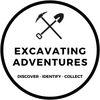In this quick and inexpensive tutorial, we are going to show you how to Make A Giant Geode Dig. These excavations are super easy to make and are a great teaching resource to include in your next lesson or discussion about geodes, rocks, minerals, geology, and more.
Be sure to check out our free Digital Dig virtual gem mining. Answer trivia and earn points you can redeem for free rocks, minerals, fossils, seashells, excavation kits and more!
Materials:
Sand
Plaster of Paris
Water
Mixing Bowl
Wooden spoon
Measuring cups
Popsicle sticks – Popsicle sticks are inexpensive, readily available, and make great excavation tools.
Safety goggles or glasses – You we need to provide or borrow a set for each student.
Optional – Brushes and magnifying glasses.
Coffee can
Geodes
Sock
Hammer
Check out hundreds of exciting and unique dig kits! Excavating Adventures has a kit for everyone. Explore dig kits filled with rocks, minerals, fossils, gemstones, seashells, and more!
Directions:
- Place some geodes in the coffee can.
- Mix 3 cups sand with 1 cup Plaster of Paris.
- Add 1 cup of water and mix until you have a pancake batter consistency.
- Pour the mixture over the geodes.
- Repeat making and adding mixture until the coffee can is nearly full.
- Place the Giant Geode Dig in front of a fan overnight until it is completely dry.
- Distribute the excavation, excavation tools, and safety goggles to your Excavating Adventurer and have fun watching them dig in and discover the awesome geodes you have hidden inside.
- Once the geodes have been discovered, place them one at a time in the sock and gently tap with the hammer until they crack open.
- Remove from the sock and enjoy!
Geode Gems: Hidden Treasures and Crystal Surprises!
Fun Facts about Geodes:
-
Geodes are geological formations that appear like ordinary rocks from the outside but contain a hollow cavity lined with beautiful crystals on the inside.
-
These fascinating structures are formed when mineral-rich water seeps into rock cavities or bubbles and gradually deposits minerals over time.
-
Geodes can come in various shapes and sizes, from small egg-shaped specimens to giant formations weighing several hundred pounds.
-
The most common crystals found inside geodes include quartz, amethyst, calcite, and agate, each displaying unique colors and patterns.
-
Geodes can be found in different parts of the world, with notable locations including Brazil, Mexico, Morocco, and the United States.
-
When a geode is cracked open, it reveals a stunning display of crystal formations, often surprising and delighting those who discover them.
-
Geodes are like hidden treasure chests, waiting to be cracked open to reveal their sparkling contents.
-
The exterior of a geode can be unremarkable, resembling an ordinary rock, but it's the secret inside that holds the true beauty.
-
Geodes have been used as decorative items and even turned into jewelry, allowing people to wear a piece of Earth's natural beauty.
-
Exploring geodes and cracking them open can be a fun and exciting activity, sparking curiosity and a sense of discovery.
-
Geodes are a reminder of the remarkable processes that occur deep within the Earth, shaping and creating these enchanting natural wonders.
-
Each geode is unique, with its own combination of crystals, colors, and patterns, making each one a truly special find.
Remember, the world of geodes is full of surprises and hidden treasures, inviting us to uncover the dazzling beauty that lies within these ordinary-looking rocks!
Take some time to explore the Excavating Adventures website. We have monthly excavations that get delivered right to your door, Build Your Own excavations, a blog filled with amazing excavation ideas, trivia, tons of free stuff and much, much, more!
Here are three multiple-choice questions based on the facts about geodes:
Question 1: What are geodes? A) Volcanic rocks B) Hollow rock cavities C) Fossilized shells D) Underwater formations
Correct answer: B) Hollow rock cavities
Question 2: What minerals are commonly found inside geodes? A) Granite and basalt B) Gypsum and limestone C) Quartz and amethyst D) Feldspar and mica
Correct answer: C) Quartz and amethyst
Question 3: What makes geodes exciting to explore? A) Their heavy weight B) Their colorful exterior C) Their hidden crystals D) Their magnetic properties
Correct answer: C) Their hidden crystals

